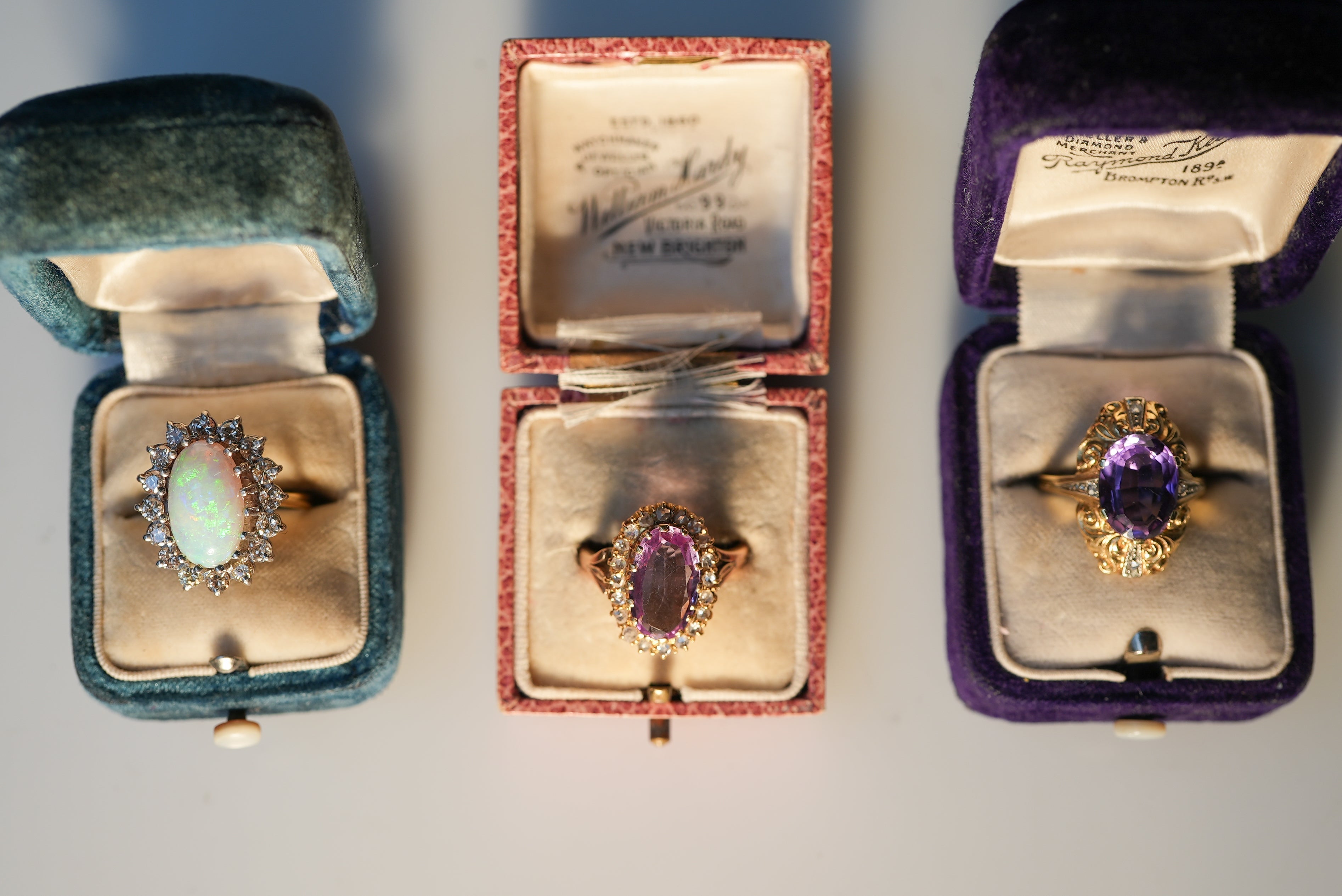A Comprehensive Guide to Semi-Precious Gemstones
At Wave Antiques, we specialise in antique and vintage jewellery featuring a wide range of gemstones. While diamonds, emeralds, sapphires and rubies are well known, many other stones were used in historic jewellery, each bringing its own qualities to period designs. This guide introduces some of the most commonly used semi-precious stones and their place in antique jewellery.
Opal
Opals were often set in Victorian rings and Edwardian brooches, valued for their shifting colours. Many were cut en cabochon and mounted in yellow gold, sometimes with a border of rose-cut diamonds. Art Deco designs used opals more sparingly but often combined them with platinum.
Explore our antique opal jewellery collection here.
Aquamarine
Aquamarine, a pale blue beryl, was popular in Art Deco rings and pendants. These stones were often emerald-cut and set in platinum or white gold alongside diamonds, highlighting their clarity. Earlier examples appear in Edwardian necklaces or Georgian drop earrings.
View our aquamarine jewellery selection here.
Amethyst
Amethyst was widely used in Victorian jewellery, particularly in brooches and lockets. It also appeared in Georgian rings, often with foil backing to enhance colour. Larger stones were sometimes set in pinchbeck or low-karat gold and framed with pearls or garnets.
Browse our antique amethyst jewellery here.
Citrine
Citrine, a golden-yellow quartz, was used in Georgian and Victorian necklaces and statement rings. Large citrines were often faceted in oval or cushion cuts and set in yellow gold, sometimes with engraved detailing or additional stones like peridot.
Explore our antique citrine jewellery here.
Pearl
Pearls were essential in Georgian and Edwardian jewellery. They appear in drop earrings, fringe necklaces, and as accents around gemstone centres. Natural pearls were preferred before the rise of cultured varieties and were often set in silver or gold with diamonds.
See our pearl jewellery range here.
Garnet
Garnet was commonly used in Victorian brooches, rings and parures. Deep red almandine garnets were often arranged in clusters or as cabochons. Bohemian garnet jewellery, featuring small faceted stones set in low-carat gold or gilt metal, was especially popular.
Browse garnet jewellery pieces here.
Peridot
Peridot was frequently used in Suffragette jewellery, often alongside amethyst and pearl. It appears in both Victorian and Edwardian rings and pendants, typically set in yellow gold with claw or bezel settings.
View our peridot jewellery collection here.
Tourmaline
Tourmaline was used in a variety of antique jewellery, particularly during the late Victorian and Art Nouveau periods. Its range of colours made it ideal for multi-stone rings, pendants, and stick pins. Pink and green tourmalines were especially popular in yellow gold settings.
Explore our tourmaline jewellery collection here.
Carnelian
Carnelian, a warm-toned quartz, was commonly used in signet rings, seals, and fobs during the Georgian and Victorian periods. Its durability made it ideal for carving. Carnelian intaglios and cameos are frequently found in lockets, rings, and watch chains.
Browse our carnelian jewellery selection here.
Topaz
Topaz, especially the golden-orange variety, was used in Georgian and early Victorian jewellery. These stones were often foil-backed and set in closed-back settings to enhance their colour. Blue topaz appeared more commonly in later 20th-century vintage pieces.
View our topaz jewellery here.
Moonstone
Moonstone was popular in Art Nouveau jewellery, often set in silver with flowing, nature-inspired designs. It also appeared in Edwardian pendants and rings, usually cabochon cut to show the internal glow known as adularescence.
View our moonstone jewellery collection here.
Turquoise
Turquoise was frequently used in Georgian and Victorian cluster rings, brooches and earrings. It was often paired with pearls or diamonds and set in yellow gold. Persian turquoise, known for its uniform colour, was particularly sought after.
Explore our turquoise jewellery here.
Agate
Agate featured prominently in Scottish jewellery of the Victorian period. It was used in brooches, bracelets and kilt pins, often cut into polished segments to show off its banding. Moss agate and Montrose agate were also set into Georgian and Edwardian lockets.
Discover our agate jewellery here.
Tanzanite
Tanzanite, discovered in the 1960s, appears in some later vintage rings and earrings. Known for its deep blue-violet hue, it is often set in white gold or platinum and combined with diamonds for added contrast.
Explore our tanzanite jewellery collection here.
Zircon
Blue zircon, known for its brilliance, was commonly used in Edwardian and Art Deco rings. It can be confused with modern cubic zirconia, but is a natural stone with its own optical properties. Zircon also appears in early 20th-century brooches and pendants.
View our zircon jewellery collection here.
Jade

Jade appears in Victorian and Art Deco pieces, especially those influenced by East Asian design. It was carved into beads, plaques, or cameos and set in bangles, earrings and necklaces. Green and white varieties are most common, but lavender jade is also seen in some vintage items.
Onyx
Onyx was used in Victorian mourning jewellery, as well as in Art Deco pieces for its bold contrast with diamonds or platinum. Common forms include signet rings, cameo brooches, and beads strung in long necklaces or paired with seed pearls.
Browse our onyx jewellery collection here.


















